
The Wentworth-Gardner House is a historic mid-Georgian house, located at 50 Mechanic Street in Portsmouth, New Hampshire, United States. The house is operated as a museum by the Wentworth-Gardner Historic House Association. It is one of the finest extant examples of high-style Georgian architecture in New England, and played a role in the architectural preservation movement of the early 20th century. It was declared a National Historic Landmark in 1968.

The Wentworth Lear Historic Houses are a pair of adjacent historic houses on the south waterfront in Portsmouth, New Hampshire. Both buildings and an 18th-century warehouse were owned by the Wentworth Lear Historic Houses and were operated as a house museum. Only the Wentworth-Gardner house is a museum. They are located at the corner of Mechanic and Gardner Streets. The two houses, built c. 1750–60, represent a study in contrast between high-style and vernacular Georgian styling. The Wentworth-Gardner House is a National Historic Landmark, and the houses are listed as the Wentworth-Gardner and Tobias Lear Houses on the National Register of Historic Places.

Cannondale Historic District is a historic district in the Cannondale section in the north-central area of the town of Wilton, Connecticut. The district includes 58 contributing buildings, one other contributing structure, one contributing site, and 3 contributing objects, over a 202 acres (82 ha). About half of the buildings are along Danbury Road and most of the rest are close to the Cannondale train station .The district is significant because it embodies the distinctive architectural and cultural-landscape characteristics of a small commercial center as well as an agricultural community from the early national period through the early 20th century....The historic uses of the properties in the district include virtually the full array of human activity in this region—farming, residential, religious, educational, community groups, small-scale manufacturing, transportation, and even government. The close physical relationship among all these uses, as well as the informal character of the commercial enterprises before the rise of more aggressive techniques to attract consumers, capture some of the texture of life as lived by prior generations. The district is also significant for its collection of architecture and for its historic significance.

The Rev. Stephen Badger House is a historic house at 87 Eliot Street in Natick, Massachusetts. Built in 1753, it was the home of Natick's last missionary to the local "Praying Indian" community, and is a prominent well-preserved surviving example of Georgian architecture. It was listed on the National Register of Historic Places in 1980.
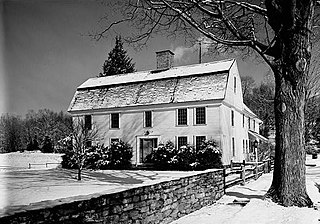
The Bradford-Huntington House is a historic house at 16 Huntington Lane in the Norwichtown section of Norwich, Connecticut, United States. The house was built in stages, beginning around 1691, and is one of the oldest to survive in the area. It was owned by American Revolutionary War officer Jabez Huntington. It is claimed that Huntington hosted George Washington here. The house was listed on the National Register of Historic Places in 1970. It is also a contributing property in the Norwichtown Historic District.

The Jabez Smith House is a historic house museum at 259 North Road in Groton, Connecticut. Built about 1783, it is the only 18th-century farmhouse to survive on Groton's Poquonock Bridge area, which was once its principal agricultural area. It is owned by the town of Groton and open to the public on weekends from April through November. It features 18th and 19th-century antiques. The house was listed on the National Register of Historic Places on May 15, 1981.

The Daniel and Esther Bartlett House is at historic house and farmstead at 43 Lonetown Road in Redding, Connecticut. Built in 1796, it is a good local example of well-preserved Federal architecture, somewhat unusual for its shingle siding. The property, now owned by the town and managed by the local historical society, also includes an 18th-century barn. The property was listed on the National Register of Historic Places on April 15, 1993.

The Col. Joshua Huntington House is a historic house at 11 Huntington Lane in Norwich, Connecticut. Built in 1771, it is a well-preserved example of Georgian architecture in the city's Norwichtown area. It was built for Joshua Huntington, scion of a prominent family and a local military leader during the American Revolutionary War. The house was listed on the National Register of Historic Places on February 23, 1972.

The John Glover House is a historic house at 53 Echo Valley Road in Newtown, Connecticut, USA. Built about 1708 by an early town settler, it is a remarkably well-preserved example of 18th-century residential architecture, owned for generations by a locally prominent farming family. The house was listed on the National Register of Historic Places in 2001.

The Marlborough Tavern, also known historically as the Col. Elisha Buell House, is a historic house and former tavern at 3 East Hampton Road in Marlborough, Connecticut. Built in 1760, it was for many years a prominent stagecoach stop, and a center of the town's civic activities. It was listed on the National Register of Historic Places in 1978.
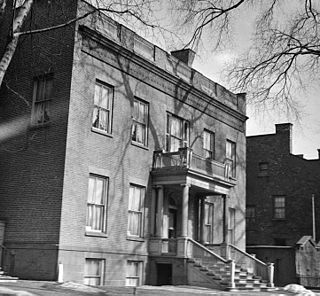
The Dr. Hun Houses were located on Washington Avenue on the western edge of central Albany, New York, United States. They were a pair of brick buildings constructed a century apart, the older one around 1830, in the Federal style. In 1972, three months after they were listed on the National Register of Historic Places, they were demolished and subsequently delisted.
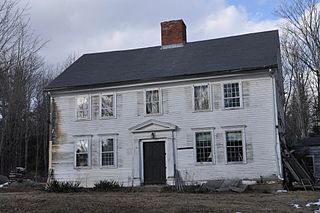
The Appleton-Hannaford House is a historic house on Hancock Road in Dublin, New Hampshire. Built about 1785 for the son of an early settler, it is one of the town's oldest surviving buildings, and a little-altered example of Georgian residential architecture. The house was listed on the National Register of Historic Places in 1983.
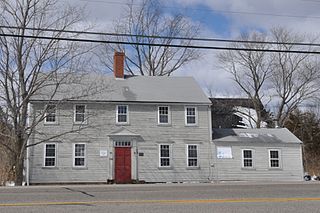
The John Crockett House, also known as Kenniston's Tavern, is a historic house at 245 Portsmouth Road in Stratham, New Hampshire in the United States. Built about 1760, it is a well-preserved example of Georgian residential architecture. It was operated for a time as a tavern serving travelers on the main road between Portsmouth and Exeter. The house was listed on the National Register of Historic Places in 1983.

The Hart-Rice House is a historic house at 408 The Hill in Portsmouth, New Hampshire. It is located on The Hill, a cluster of closely spaced historic buildings southeast of Deer Street, some of which were moved to the site as part of a road widening project. Built sometime between 1749 and 1756, it is a little-altered example of Georgian architecture with only modest Federal period alterations. It was listed on the National Register of Historic Places in 1972.
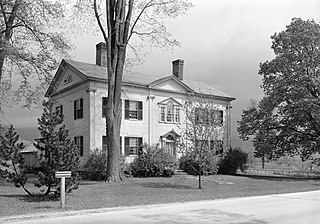
The Munro-Hawkins House is a historic house on Vermont Route 7A in southern Shaftsbury, Vermont. Built in 1807, it is a well-preserved example of transitional Georgian-Federal period architecture, designed by local master builder Lavius Fillmore. It was listed on the National Register of Historic Places in 1973.
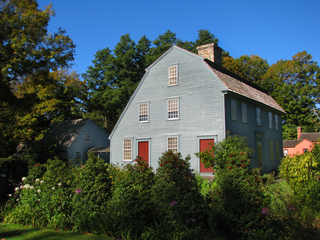
The Glebe House is a historic house museum at 49 Hollow Road in Woodbury, Connecticut. Built about 1740, it is a prominent local example of Georgian colonial architecture. It is also important as the site of the first Episcopal Church election in the United States.

The Whittier House is a historic house on Greenbanks Hollow Road in Danville, Vermont. Built in 1785, it is significant as one of the town's oldest surviving buildings, and as an example of a gambrel-roofed Cape, a style rare in northern Vermont but common to Essex County, Massachusetts, where its builder was from. The house was listed on the National Register of Historic Places in 1984.
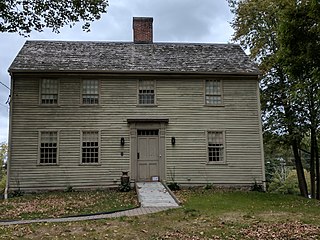
The David Sherman House is a historic house on Middle Quarter Road in Woodbury, Connecticut. Built about 1760, it is a well-preserved example of Colonial architecture. In 1781, David Sherman is reported to have hosted a ball for officers of the French Army of the Comte de Rochambeau during their march across Connecticut. The house was listed on the National Register of Historic Places in 2002.

The Judah Holcomb House was a historic house at 257 North Granby Road in Granby, Connecticut, Built in 1776, it was a well-preserved example of late Georgian architecture, notable for its elaborate entry surround and its wealth of interior woodwork. It was listed on the National Register of Historic Places in 1988.

The Bushnell-Dickinson House is a historic house at 170 Old Post Road in Old Saybrook, Connecticut. With a construction history dating to about 1790, it is a fine local example of Federal period residential architecture. The house was listed on the National Register of Historic Places in 1978.






















